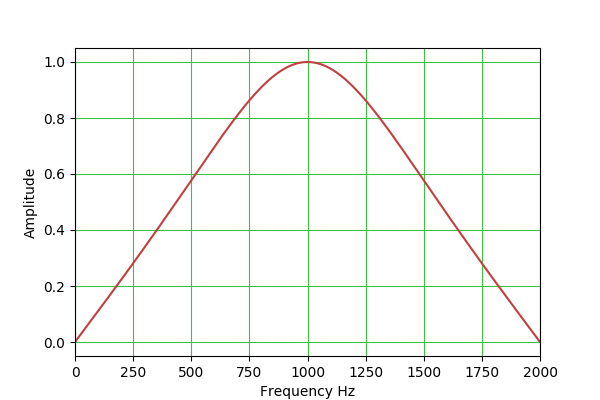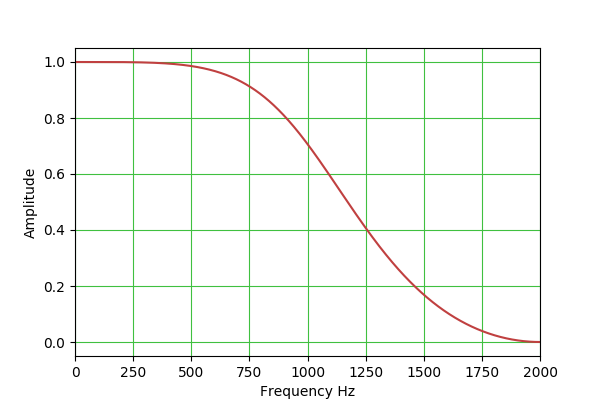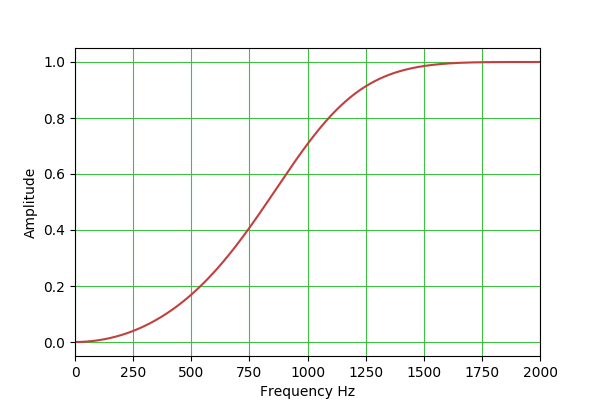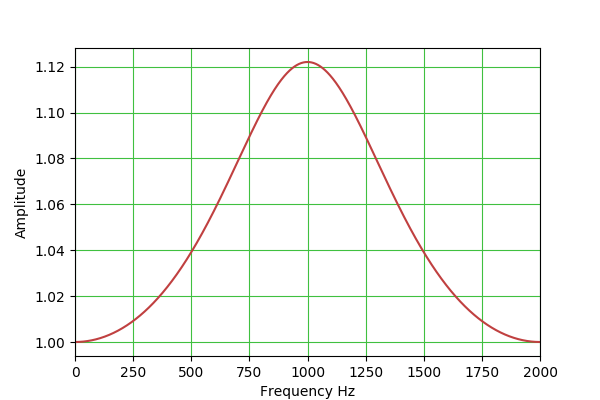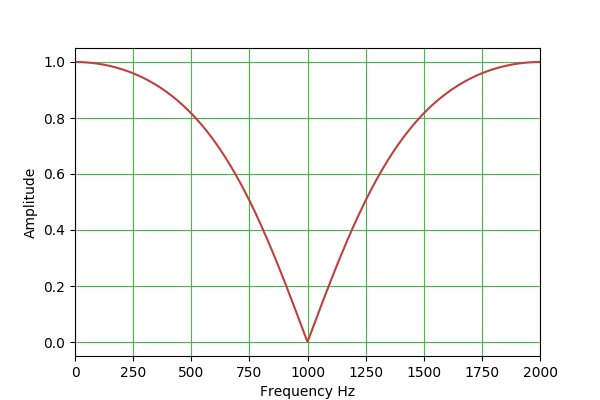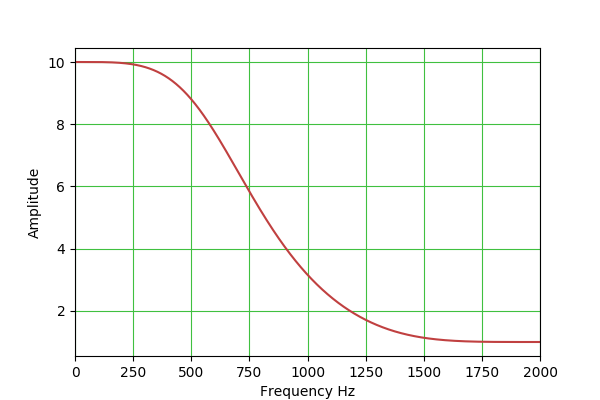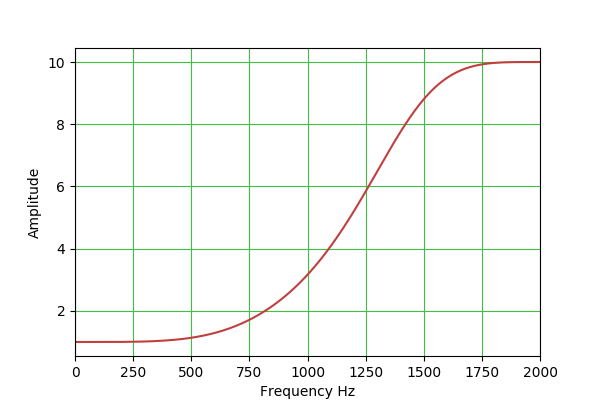转载:EQ--biquad filter
http://www.musicdsp.org/files/Audio-EQ-Cookbook.txt
https://arachnoid.com/BiQuadDesigner/index.html
https://blog.csdn.net/hunterhuang2013/article/details/64443718
Cookbook formulae for audio EQ biquad filter coefficients
----------------------------------------------------------------------------
by Robert Bristow-Johnson <rbj@audioimagination.com> All filter transfer functions were derived from analog prototypes (that
are shown below for each EQ filter type) and had been digitized using the
Bilinear Transform. BLT frequency warping has been taken into account for
both significant frequency relocation (this is the normal "prewarping" that
is necessary when using the BLT) and for bandwidth readjustment (since the
bandwidth is compressed when mapped from analog to digital using the BLT). First, given a biquad transfer function defined as: b0 + b1*z^-1 + b2*z^-2
H(z) = ------------------------ (Eq 1)
a0 + a1*z^-1 + a2*z^-2 This shows 6 coefficients instead of 5 so, depending on your architechture,
you will likely normalize a0 to be 1 and perhaps also b0 to 1 (and collect
that into an overall gain coefficient). Then your transfer function would
look like: (b0/a0) + (b1/a0)*z^-1 + (b2/a0)*z^-2
H(z) = --------------------------------------- (Eq 2)
1 + (a1/a0)*z^-1 + (a2/a0)*z^-2 or 1 + (b1/b0)*z^-1 + (b2/b0)*z^-2
H(z) = (b0/a0) * --------------------------------- (Eq 3)
1 + (a1/a0)*z^-1 + (a2/a0)*z^-2 The most straight forward implementation would be the "Direct Form 1"
(Eq 2): y[n] = (b0/a0)*x[n] + (b1/a0)*x[n-1] + (b2/a0)*x[n-2]
- (a1/a0)*y[n-1] - (a2/a0)*y[n-2] (Eq 4) This is probably both the best and the easiest method to implement in the
56K and other fixed-point or floating-point architechtures with a double
wide accumulator. Begin with these user defined parameters: Fs (the sampling frequency) f0 ("wherever it's happenin', man." Center Frequency or
Corner Frequency, or shelf midpoint frequency, depending
on which filter type. The "significant frequency".) dBgain (used only for peaking and shelving filters) Q (the EE kind of definition, except for peakingEQ in which A*Q is
the classic EE Q. That adjustment in definition was made so that
a boost of N dB followed by a cut of N dB for identical Q and
f0/Fs results in a precisely flat unity gain filter or "wire".) _or_ BW, the bandwidth in octaves (between -3 dB frequencies for BPF
and notch or between midpoint (dBgain/2) gain frequencies for
peaking EQ) _or_ S, a "shelf slope" parameter (for shelving EQ only). When S = 1,
the shelf slope is as steep as it can be and remain monotonically
increasing or decreasing gain with frequency. The shelf slope, in
dB/octave, remains proportional to S for all other values for a
fixed f0/Fs and dBgain. Then compute a few intermediate variables: A = sqrt( 10^(dBgain/20) )
= 10^(dBgain/40) (for peaking and shelving EQ filters only) w0 = 2*pi*f0/Fs cos(w0)
sin(w0) alpha = sin(w0)/(2*Q) (case: Q)
= sin(w0)*sinh( ln(2)/2 * BW * w0/sin(w0) ) (case: BW)
= sin(w0)/2 * sqrt( (A + 1/A)*(1/S - 1) + 2 ) (case: S) FYI: The relationship between bandwidth and Q is
1/Q = 2*sinh(ln(2)/2*BW*w0/sin(w0)) (digital filter w BLT)
or 1/Q = 2*sinh(ln(2)/2*BW) (analog filter prototype) The relationship between shelf slope and Q is
1/Q = sqrt((A + 1/A)*(1/S - 1) + 2) 2*sqrt(A)*alpha = sin(w0) * sqrt( (A^2 + 1)*(1/S - 1) + 2*A )
is a handy intermediate variable for shelving EQ filters. Finally, compute the coefficients for whichever filter type you want:
(The analog prototypes, H(s), are shown for each filter
type for normalized frequency.) LPF: H(s) = 1 / (s^2 + s/Q + 1) b0 = (1 - cos(w0))/2
b1 = 1 - cos(w0)
b2 = (1 - cos(w0))/2
a0 = 1 + alpha
a1 = -2*cos(w0)
a2 = 1 - alpha HPF: H(s) = s^2 / (s^2 + s/Q + 1) b0 = (1 + cos(w0))/2
b1 = -(1 + cos(w0))
b2 = (1 + cos(w0))/2
a0 = 1 + alpha
a1 = -2*cos(w0)
a2 = 1 - alpha BPF: H(s) = s / (s^2 + s/Q + 1) (constant skirt gain, peak gain = Q) b0 = sin(w0)/2 = Q*alpha
b1 = 0
b2 = -sin(w0)/2 = -Q*alpha
a0 = 1 + alpha
a1 = -2*cos(w0)
a2 = 1 - alpha BPF: H(s) = (s/Q) / (s^2 + s/Q + 1) (constant 0 dB peak gain) b0 = alpha
b1 = 0
b2 = -alpha
a0 = 1 + alpha
a1 = -2*cos(w0)
a2 = 1 - alpha notch: H(s) = (s^2 + 1) / (s^2 + s/Q + 1) b0 = 1
b1 = -2*cos(w0)
b2 = 1
a0 = 1 + alpha
a1 = -2*cos(w0)
a2 = 1 - alpha APF: H(s) = (s^2 - s/Q + 1) / (s^2 + s/Q + 1) b0 = 1 - alpha
b1 = -2*cos(w0)
b2 = 1 + alpha
a0 = 1 + alpha
a1 = -2*cos(w0)
a2 = 1 - alpha peakingEQ: H(s) = (s^2 + s*(A/Q) + 1) / (s^2 + s/(A*Q) + 1) b0 = 1 + alpha*A
b1 = -2*cos(w0)
b2 = 1 - alpha*A
a0 = 1 + alpha/A
a1 = -2*cos(w0)
a2 = 1 - alpha/A lowShelf: H(s) = A * (s^2 + (sqrt(A)/Q)*s + A)/(A*s^2 + (sqrt(A)/Q)*s + 1) b0 = A*( (A+1) - (A-1)*cos(w0) + 2*sqrt(A)*alpha )
b1 = 2*A*( (A-1) - (A+1)*cos(w0) )
b2 = A*( (A+1) - (A-1)*cos(w0) - 2*sqrt(A)*alpha )
a0 = (A+1) + (A-1)*cos(w0) + 2*sqrt(A)*alpha
a1 = -2*( (A-1) + (A+1)*cos(w0) )
a2 = (A+1) + (A-1)*cos(w0) - 2*sqrt(A)*alpha highShelf: H(s) = A * (A*s^2 + (sqrt(A)/Q)*s + 1)/(s^2 + (sqrt(A)/Q)*s + A) b0 = A*( (A+1) + (A-1)*cos(w0) + 2*sqrt(A)*alpha )
b1 = -2*A*( (A-1) + (A+1)*cos(w0) )
b2 = A*( (A+1) + (A-1)*cos(w0) - 2*sqrt(A)*alpha )
a0 = (A+1) - (A-1)*cos(w0) + 2*sqrt(A)*alpha
a1 = 2*( (A-1) - (A+1)*cos(w0) )
a2 = (A+1) - (A-1)*cos(w0) - 2*sqrt(A)*alpha FYI: The bilinear transform (with compensation for frequency warping)
substitutes: 1 1 - z^-1
(normalized) s <-- ----------- * ----------
tan(w0/2) 1 + z^-1 and makes use of these trig identities: sin(w0) 1 - cos(w0)
tan(w0/2) = ------------- (tan(w0/2))^2 = -------------
1 + cos(w0) 1 + cos(w0) resulting in these substitutions: 1 + cos(w0) 1 + 2*z^-1 + z^-2
1 <-- ------------- * -------------------
1 + cos(w0) 1 + 2*z^-1 + z^-2 1 + cos(w0) 1 - z^-1
s <-- ------------- * ----------
sin(w0) 1 + z^-1 1 + cos(w0) 1 - z^-2
= ------------- * -------------------
sin(w0) 1 + 2*z^-1 + z^-2 1 + cos(w0) 1 - 2*z^-1 + z^-2
s^2 <-- ------------- * -------------------
1 - cos(w0) 1 + 2*z^-1 + z^-2 The factor: 1 + cos(w0)
-------------------
1 + 2*z^-1 + z^-2 is common to all terms in both numerator and denominator, can be factored
out, and thus be left out in the substitutions above resulting in: 1 + 2*z^-1 + z^-2
1 <-- -------------------
1 + cos(w0) 1 - z^-2
s <-- -------------------
sin(w0) 1 - 2*z^-1 + z^-2
s^2 <-- -------------------
1 - cos(w0) In addition, all terms, numerator and denominator, can be multiplied by a
common (sin(w0))^2 factor, finally resulting in these substitutions: 1 <-- (1 + 2*z^-1 + z^-2) * (1 - cos(w0)) s <-- (1 - z^-2) * sin(w0) s^2 <-- (1 - 2*z^-1 + z^-2) * (1 + cos(w0)) 1 + s^2 <-- 2 * (1 - 2*cos(w0)*z^-1 + z^-2) The biquad coefficient formulae above come out after a little
simplification. Biquadratic difference equation flow graph
(horizontal = time, vertical = data flow):

// perform one filtering step
double filter(double x) {
y = b0 * x + b1 * x1 + b2 * x2 - a1 * y1 - a2 * y2;
x2 = x1;
x1 = x;
y2 = y1;
y1 = y;
return (y);
}
This table outlines the properties of the available filter types:
Filter Type Q adj Gain adj Comments Image Bandpass Y N The most generally useful filter type. Low-pass Y N For low-pass and high-pass biquadratic filters, one normally sets Q = 0.707 ($\frac{1}{\sqrt{2}}$) to achieve a Butterworth filter transfer function with a 3 DB drop at the specified operating frequency. Higher Q settings produce an often-undesirable peak near the center frequency and dynamic instability in operation. High-pass Y N Peak Y Y This filter is a bit tricky to set up, because both Q and gain are effective. The idea is that one can use the gain control to set a nonzero base gain level that applies to all frequencies, then use the frequency and Q controls to set a narrow peak to exceed that level. Note also that, with a negative gain setting, the relation between the plateau and peak is reversed. Notch Y N This filter is more or less the opposite of the "Peak" filter — it creates a narrow rejection band, the width of which is set by the Q control. (But no plateau as with "Peak".) Lowshelf N Y Lowshelf and highshelf filters provide a sort of "plateau" effect, under control of the gain setting, and not unlike the "Peak" filter described above. Note that negative gain settings reverse the identity of the filter — lowshelf becomes highshelf and the reverse. Highshelf N Y
转载:EQ--biquad filter的更多相关文章
- Digital biquad filter
Direct Form 1 The most straightforward implementation is the Direct Form 1, which has the following ...
- 【转载】CSS3 filter:drop-shadow滤镜与box-shadow区别应用
文章转载自 张鑫旭-鑫空间-鑫生活 http://www.zhangxinxu.com/wordpress/ 原文链接:http://www.zhangxinxu.com/wordpress/?p=5 ...
- jquery 常用选择器 回顾 ajax() parent() parents() children() siblings() find() eq() has() filter() next()
1. $.ajax() ajax 本身是异步操作,当需要将 异步 改为 同步时: async: false 2.parent() 父级元素 和 parents() 祖先元素 的区别 parent ...
- 【转载】CSS filter:hue-rotate色调旋转滤镜实现按钮批量生产
文章转载自 张鑫旭-鑫空间-鑫生活 http://www.zhangxinxu.com/ 原文链接:https://www.zhangxinxu.com/wordpress/2018/11/css-f ...
- [转载]OpenFileDialog对话框Filter属性
首先说明一个示例,分析一下Filter属性的构成:“ Excel文件|*.xls ”,前面的“Excel文件”成为标签,是一个可读的字符串,可以自定定义,“|*.xls”是筛选器,表示筛选文件夹中后缀 ...
- 【转载】Servlet Filter(过滤器)、Filter是如何实现拦截的、Filter开发入门
Servlet Filter(过滤器).Filter是如何实现拦截的.Filter开发入门 Filter简介 Filter也称之为过滤器,它是Servlet技术中最激动人心的技术,WEB开发人员通过F ...
- 转载:Angular的filter总结
过滤器(filter)正如其名,作用就是接收一个输入,通过某个规则进行处理,然后返回处理后的结果.主要用在数据的格式化上,例如获取一个数组 中的子集,对数组中的元素进行排序等.ng内置了一些过滤器,它 ...
- biquad filter实现
原始频谱: LPF: HPF: 代码: #include<stdio.h> #include<stdlib.h> #include<errno.h> #includ ...
- 转载:polyphase filter
http://www.ws.binghamton.edu/fowler/fowler%20personal%20page/ee521.htm http://www.ws.binghamton.edu/ ...
随机推荐
- elasticsearch index 过程
(1)index request 到某一个Node(选择node的方式是采用round-robin)方法,此node 称为coordinate node,继续当前index request应该执行在哪 ...
- 区间dp(模板+例题)
参考博文:区间dp小结(附经典例题) 首先,什么是区间dp?它是干什么的? 先在小区间进行DP得到最优解,然后再利用小区间的最优解合并求大区间的最优解 操作往往涉及到区间合并问题 以上. 模板如下: ...
- 【大道至简】NetCore3.1快速开发框架一:集成Swagger
在上一章节中,我们创建了基本的框架结构:https://www.cnblogs.com/fuyu-blog/p/12217647.html 下面我们测试接口和集成Swagger接口文档 一.接口测试 ...
- SmtpStatusCode Enum
- JavaDay2(上)
Java learning_Day2(上) 本人学习视频用的是马士兵的,也在这里献上 <链接:https://pan.baidu.com/s/1qKNGJNh0GgvlJnitTJGqgA> ...
- docker的个人理解
一.什么是docker? docker就是集装箱的原理.可以实现远超于虚拟机的轻量级虚拟化.它是内核级的虚拟化.期望达到使项目运行环境一次封装,到处运行的目的. 集装箱解决了什么问题?在一艘大船上,可 ...
- c++ STL vector初步学习
/*vector(向量):是一种顺序容器,,动态数组,事实上和数组差不多,但它比数组更优越.一般来说数组不能动态拓展,因此在程序运行的时候不是浪费内存,就是造成越界.而vector正好弥补了这个缺陷, ...
- Hdu2099 整除的尾数
题目链接:http://acm.hdu.edu.cn/showproblem.php?pid=2099 Problem Description 一个整数,只知道前几位,不知道末二位,被另一个整数除尽了 ...
- 安装sublime简易笔记
1.安装编码工具sublime text3(下载地址,软件管家网盘) 2.安装完成后,下载sublime text3中与python相关的插件:package control 进入package co ...
- Codeforces Round #619 (Div. 2) A~D题解
最近网课也开始了,牛客上一堆比赛题目也没补,所以就D题后面的也懒得补了 A.Three String 水题 #include <cstdio> #include <cstring&g ...

